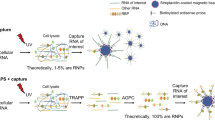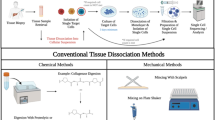Abstract
SEPARATION techniques involving gel electrophoresis recently introduced for high molecular weight RNA molecules are most useful, compared with sedimentation analysis, in making possible increased resolution of migrating RNA species. Electrophoretic techniques are also valuable because they can be scaled down to make analysis of RNA from the single cell relatively easy. Single cell analysis was originally developed by Daneholt et al.1, who used agarose gels for separating the ribosomal RNAs and 4S RNA. This purpose, however, can be served better with the use of composite polyacrylamide–agarose gels that improve separation (see following communication). Separation of the relatively low molecular weight species of RNA (species smaller than 16S size) on a small scale is, on the other hand, best carried out in relatively concentrated polyacrylamide gels. We describe here the isolation and separation of RNA from individually isolated cell components from salivary gland polytene cells. We also show that the information which can be obtained in this way is of unique value, because well defined structural components can be isolated separately from a fixed tissue preparation without exposing the tissue components to aqueous fluids during the isolations, with the consequent uncertainties about the origin and native state of the analysed nucleic acid.
This is a preview of subscription content, access via your institution
Access options
Subscribe to this journal
Receive 51 print issues and online access
$199.00 per year
only $3.90 per issue
Buy this article
- Purchase on Springer Link
- Instant access to full article PDF
Prices may be subject to local taxes which are calculated during checkout
Similar content being viewed by others
References
Daneholt, B., Ringborg, U., Egyházi, E., and Lambert, B., Nature, 218, 292 (1968).
Edström, J.-E., and Daneholt, B., J. Mol. Biol., 28, 331 (1967).
Edström, J.-E., in Methods in Cell Physiology (edit. by Prescott, D. M.), 417 (Academic Press, New York, 1964).
Loening, U. E., Biochem. J., 102, 251 (1967).
Comb, D. G., and Katz, S., J. Mol. Biol., 8, 790 (1964).
Sirlin, J. L., Jacob, J., and Birnstiel, M. L., Nat. Cancer Inst. Monog., 23, 255 (1966).
Perry, R. P., Proc. US Nat. Acad. Sci., 48, 2179 (1962).
Ritossa, F. M., Atwood, K. C., and Spiegelman, S., Genetics, 54, 663 (1966).
Knight, E., and Darnell, J. E., J. Mol. Biol., 28, 491 (1967).
Author information
Authors and Affiliations
Rights and permissions
About this article
Cite this article
EGYHÁZI, E., RINGBORG, U., DANEHOLT, B. et al. Extraction and Fractionation of Low Molecular Weight RNA on the Microscale. Nature 220, 1036–1037 (1968). https://doi.org/10.1038/2201036a0
Received:
Issue Date:
DOI: https://doi.org/10.1038/2201036a0
Comments
By submitting a comment you agree to abide by our Terms and Community Guidelines. If you find something abusive or that does not comply with our terms or guidelines please flag it as inappropriate.



